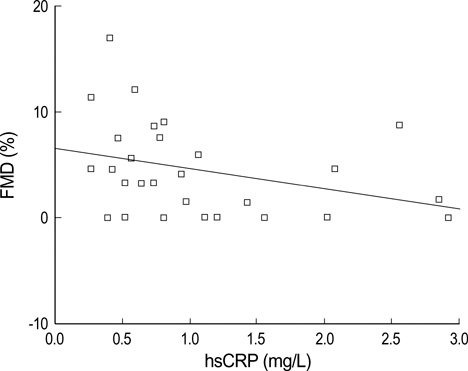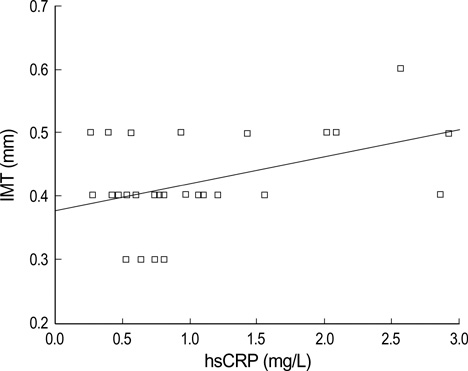J Korean Med Sci.
2007 Apr;22(2):192-197. 10.3346/jkms.2007.22.2.192.
A Useful Predictor of Early Atherosclerosis in Obese Children: Serum High-sensitivity C-reactive Protein
- Affiliations
-
- 1Department of Pediatrics, College of Medicine, Konyang University, Daejeon, Korea. kcm1000@kyuh.co.kr
- KMID: 1713159
- DOI: http://doi.org/10.3346/jkms.2007.22.2.192
Abstract
- Childhood obesity seems to contribute to the development of vascular inflammation and the progression of arterial wall changes. High-sensitivity C-reactive protein (hs-CRP) has recently emerged as a useful biomarker for vascular inflammation associated with atherosclerosis. The objectives of this study were to evaluate the association of the serum hs-CRP level with ultrasonic findings of early atherosclerosis, carotid intima-media wall thickness (IMT) and brachial flow-mediated dilation (FMD), in obese children. Thirty eight obese children and 45 sex/age-matched healthy control children were recruited. Serum CRP levels were measured by the high-sensitive latex turbidimetric immunoassay, and we measured carotid IMT and brachial FMD using high-resolution B-mode ultrasonography. Obese children had significantly higher hs-CRP levels (1.40+/-0.74 mg/L vs. 0.55+/-0.49 mg/L, p<0.01), as well as increased IMT (0.52+/-0.09 mm vs. 0.41+/-0.07 mm, p<0.01) and impaired FMD (7.35+/-7.78% vs. 20.34+/-16.81%, p<0.01) compared to healthy controls. Serum hs-CRP correlated positively with IMT (r=0.413, p<0.05) and inversely with FMD (r=-0.350, p<0.05) in the obesity group. Measurement of the serum hs-CRP level is a simple, cheap, and highly reproducible assay and correlates with IMT and FMD in obese children. Thus, it would be a useful marker for evaluating and estimating the degree of atherosclerosis in children.
MeSH Terms
Figure
Cited by 1 articles
-
Serum albumin levels and their correlates among individuals with motor disorders at five institutions in Japan
Hiroko Ohwada, Takeo Nakayama, Yuki Kanaya, Yuki Tanaka
Nutr Res Pract. 2017;11(1):57-63. doi: 10.4162/nrp.2017.11.1.57.
Reference
-
1. Haverkate F, Thompson SG, Pyke SD, Gallimore JR, Pepys MB. Production of C-reactive protein and risk of coronary events in stable and unstable angina. European Concerted Action on Thrombosis and Disabilities Angina Pectoris Study Group. Lancet. 1997. 349:462–466.2. Liuzzo G, Biasucci LM, Gallimore JR, Grillo RL, Rebuzzi AG, Pepys MB, Maseri A. The prognostic value of C-reactive protein and serum amyloid A protein in severe unstable angina. N Engl J Med. 1994. 331:417–424.
Article3. Kuller LH, Tracy RP, Shaten J, Meilahn FN. Relation of C-reactive protein and coronary heart disease in the MRFIT nested case-control study. Multiple Risk Factor Intervention Trial. Am J Epidemiol. 1996. 144:537–547.4. Ogden DL, Kuczmarski RJ, Flegal KM, Mel Z, Guo S, Wel R, Grummer-Strawn LM, Gurtin LR, Roche AF, Johnson CL. Centers for Disease Control and Prevention 2000 growth charts for the United States: improvements to the 1977 National Center for Health Statistics version. Pediatrics. 2002. 109:45–60.
Article5. Saito M, Ishimitsu T, Minami J, Ono H, Ohrui M, Matsuoka H. Relations of plasma high-sensitivity C-reactive protein to traditional cardiovascular risk factors. Atherosclerosis. 2003. 167:73–79.
Article6. Ryu SY, Lee YS, Park J, Kang MG, Kim KS. Relations of plasma high-sensitivity C-reactive protein to various cardiovascular risk factors. J Korean Med Sci. 2005. 20:379–383.
Article7. Sitzer M, Markus HS, Mendall MA, Liehr R, Knorr U, Steinmetz H. C-reactive protein and carotid intimal medial thickness in a community population. J Cardiovasc Risk. 2002. 9:97–103.
Article8. Hashimoto H, Kitagawa K, Hougaku H, Shimizu Y, Sakaguchi M, Nagai Y, Iyama S, Yamanishi H, Matsumoto M, Hori M. C-reactive protein is an independent predictor of the rate of increase in early carotid atherosclerosis. Circulation. 2001. 104:63–67.
Article9. Rifai N, Ridker PM. High-sensitivity C-reactive protein: a novel and promising marker of coronary heart disease. Clinical Chemistry. 2001. 47:403–411.
Article10. Rohde LE, Hennekens CH, Ridker PM. Survey of C-reactive protein and cardiovascular risk factors in apparently healthy men. Am J Cardiol. 1999. 84:1018–1022.
Article11. Jarvisalo MJ, Raitakari M, Toikka JO, Putto-Laurila A, Rontu R, Laine S, Lehtimaki T, Ronnemaa T, Viikari J, Raitakari OT. Endothelial dysfunction and increased arterial intima-media thickness in children with type 1 diabetes. Circulation. 2004. 109:1750–1755.
Article12. Joannides R, Haefeli WE, Linder L, Richard V, Bakkali EH, Thuillez C, Luscher TF. Nitric oxide is responsible for flow-dependent dilatation of human peripheral conduit arteries in vivo. Circulation. 1995. 92:1314–1319.
Article13. Celermajer DS, Sorensen KE, Gooch VM, Spiegelhalter DJ, Miller OI, Sullivan ID, Lloyd JK, Deanfield JE. Non-invasive detection of endothelial dysfunction in children and adults at risk of atherosclerosis. Lancet. 1992. 340:1111–1115.
Article14. Singh TP, Groehn H, Kazmers A. Vascular function and carotid intimal-medial thickness in children with insulin-dependent diabetes mellitus. J Am Coll Cardiol. 2003. 41:661–665.
Article15. Zhu W, Huang X, He J, Li M, Neubauer H. Arterial intima-media thickening and endothelial dysfunction in obese chinese children. Eur J Pediatr. 2005. 164:337–344.
Article16. Kim YJ, Shim YH, Yoo JH, Lee K, Hong YM. Measurement of the common carotid artery by ultrasound as a predictor of atherosclerosis in obese adolescents. Korean J Pediatr. 2005. 48:745–752.17. Woo KS, Chook P, Yu CW, Sung RY, Qiao M, Leung SS, Lam CW, Metreweli C, Celermajer DS. Overweight in children is associated with arterial endothelial dysfunction and intima-media thickening. Int J Obes Relat Metab Disord. 2004. 28:852–857.
Article18. Ross R. Atherosclerosis-an inflammatory disease. New Engl J Med. 1999. 340:115–126.19. Cook DG, Mendall MA, Whincup PH, Carey IM, Ballam L, Morris JE, Miller GJ, Strachan DP. C-reactive protein concentration in children: relationship to adiposity and other cardiovascular risk factors. Atherosclerosis. 2000. 149:139–150.
Article20. Hak AE, Stehouwer CD, Bots ML, Polderman KH, Schalkwijk CG, Westendorp IC, Hofman A, Witteman JC. Association of C-reactive protein with measures of obesity, insulin resistance, and subclinical atherosclerosis in healthy, middle aged women. Arterioscler Thromb Vasc Biol. 1999. 19:1986–1991.21. Bassuk SS, Rifai N, Ridker PM. High-sensitivity C-reactive protein: clinical importance. Curr Probl Cardiol. 2004. 29:439–493.22. Wu DM, Chu NF, Shen MH, Chang JB. Plasma C-reactive protein levels and their relationship to anthropometric and lipid characteristics among children. J Clin Epidemiol. 2003. 56:94–100.
Article23. Hayaishi-Okano R, Yamasaki Y, Katakami N, Ohtoshi K, Gorogawa S, Kuroda A, Matsuhisa M, Kosugi K, Nishikawa N, Kajimoto Y, Hori M. Elevated C-reactive protein associates with early-stage carotid atherosclerosis in young subjects with type 1 diabetes. Diabetes Care. 2002. 25:1432–1438.
Article24. Fichtlscherer S, Rosenberger G, Walter DH, Breuer S, Dimmeler S, Zeiher AM. Elevated C-reactive protein levels and impaired endothelial vasoreactivity in patients with coronary artery disease. Circulation. 2000. 102:1000–1006.
Article25. Tan KC, Chow WS, Tam SC, Ai VH, Lam CH, Lam KS. Atorvastatin lowers C-reactive protein and improves endothelium-dependent vasodilation in type 2 diabetes mellitus. J Clin Endocrinol Metab. 2002. 87:563–568.
Article26. Jarvisalo MJ, Harmoinen A, Hakanen M, Paakkunainen U, Viikari J, Hartiala J, Lehtimaki T, Simell O, Raitakari OT. Elevated serum C-reactive protein levels and early arterial changes in healthy children. Arterioscler Thromb Vasc Biol. 2002. 22:1323–1328.27. Mangge H, Schauenstein K, Stroedter L, Griesl A, Maerz W, Borkenstein M. Low grade inflammation in juvenile obesity and type 1 diabetes associated with early signs of atherosclerosis. Exp Clin Endocrinol Diabetes. 2004. 112:378–382.
Article
- Full Text Links
- Actions
-
Cited
- CITED
-
- Close
- Share
- Similar articles
-
- Serum high sensitivity C-reactive protein levels in obese middle school boys
- High Sensitivity CRP, Fibrinogen and Homocysteine in Relation to Carotid Intima-media Thickness in Acute Ischemic Stroke
- Risk Factor and Prevention of Coronary Artery Disease
- The Relationship between Serum Ferritin and High Sensitivity C-reactive Protein among Adults in a Health Promotion Center
- Cardiovascular risk factors of early atherosclerosis in school-aged children after Kawasaki disease



